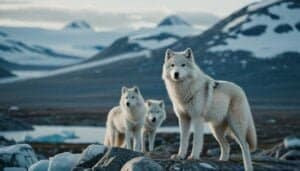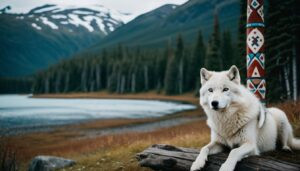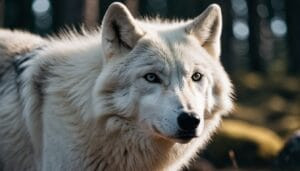Introduction
Arctic wolves hold a significant place in Inuit legends, symbolizing a variety of profound qualities and spiritual connections. Throughout this article, we will explore the roles these majestic creatures play in Inuit mythology, from guardians and protectors to messengers and symbols of endurance
We’ll delve into their traits as depicted in Inuit culture, their spiritual significance, and how they are represented in Inuit art and storytelling
Additionally, we’ll recount some of the most famous legends featuring Arctic wolves, providing a comprehensive understanding of their symbolic meaning in Inuit traditions
The Role of Arctic Wolves in Inuit Mythology
Arctic wolves, known for their resilience and adaptability, play pivotal roles in Inuit mythology, embodying various symbolic meanings
In the harsh environment of the Arctic, these wolves are seen not just as animals but as significant spiritual entities that represent multiple aspects of Inuit life and belief. The following sections explore the specific roles Arctic wolves fulfill in Inuit mythology
Guardians and Protectors
Arctic wolves are often depicted as guardians and protectors in Inuit legends. They are believed to safeguard the Inuit people from both physical and spiritual threats. This role stems from the wolves’ natural behaviors in the wild, where they protect their packs and territories with fierce loyalty
The Inuit have extended this protective nature into their myths, where wolves are seen as protectors of the community and the land. These wolves are thought to ward off evil spirits and guide the souls of the deceased to the afterlife, ensuring they reach their final resting place safely
Messengers and Guides
In many Inuit stories, Arctic wolves serve as messengers and guides between the physical world and the spiritual realm. They are considered intermediaries who carry messages from the gods or ancestors to the people
This belief is rooted in the wolves’ ability to navigate the vast, harsh Arctic landscape with ease, symbolizing their connection to the unknown and the mystical. For instance, some legends tell of wolves appearing in dreams to provide guidance or warnings, helping the Inuit make crucial decisions or avoid danger
Symbols of Strength and Endurance
Arctic wolves symbolize strength and endurance, reflecting the qualities necessary for survival in the extreme conditions of the Arctic. The Inuit hold these traits in high regard, as they are essential for thriving in their environment
Stories often highlight the wolves’ ability to endure long, harsh winters and travel great distances in search of food. This endurance is seen as a metaphor for the resilience of the Inuit people themselves, who must similarly navigate and survive in a challenging landscape. The wolves’ strength and endurance serve as a source of inspiration, encouraging the Inuit to persevere through their own hardship
Arctic wolves are deeply woven into the fabric of Inuit mythology, representing guardianship, guidance, and resilience
Their presence in these legends underscores the profound respect and admiration the Inuit have for these animals, viewing them as vital spiritual beings who embody essential qualities for survival and protection. Through the symbolic roles of Arctic wolves, the Inuit culture emphasizes the importance of community, strength, and connection to the spiritual world
Traits of Arctic Wolves in Inuit Culture
Arctic wolves are revered in Inuit culture for their distinctive traits, which mirror the qualities valued by the Inuit people
These traits are often highlighted in stories, art, and daily life, reinforcing the deep connection between the wolves and the Inuit. Below, we delve into the specific traits of Arctic wolves that hold significant cultural importance
Wisdom and Intelligence
Arctic wolves are often depicted as wise and intelligent beings in Inuit culture. This perception stems from the wolves’ strategic hunting techniques and their ability to survive in the harsh Arctic environment
The Inuit observe and respect the wolves’ keen sense of awareness and their ability to make quick, intelligent decisions, which are crucial for survival. In many legends, wolves are portrayed as cunning and knowledgeable creatures, capable of outsmarting both prey and predators
This wisdom is admired and often reflected in Inuit teachings, where the wolves’ strategies and behaviors are used as examples for problem-solving and critical thinking
Loyalty and Social Bonds
Loyalty and strong social bonds are among the most revered traits of Arctic wolves in Inuit culture. Wolves are known for their tight-knit packs and their cooperative nature, working together to hunt and protect one another
This sense of loyalty and community is mirrored in Inuit society, where family and social cohesion are paramount. Stories and legends often highlight the wolves’ dedication to their pack members, illustrating the importance of mutual support and solidarity
The Inuit see the wolves’ loyalty as a model for their own relationships, emphasizing the value of staying true to one’s family and community
Adaptability and Survival
The adaptability and survival skills of Arctic wolves are highly esteemed in Inuit culture. These wolves thrive in one of the planet’s most extreme environments, demonstrating remarkable resilience and resourcefulness
The Inuit admire the wolves’ ability to adapt to changing conditions, whether it be weather, availability of prey, or territorial challenges. This adaptability is a crucial trait for the Inuit as well, who must continuously adjust to the harsh and unpredictable Arctic climate
Legends often depict wolves overcoming significant obstacles through their adaptability, serving as a powerful metaphor for the Inuit’s own survival and adaptability in their environment
Inuit culture celebrates the wisdom, loyalty, and adaptability of Arctic wolves, recognizing these traits as essential for survival and prosperity. By observing and venerating these animals, the Inuit draw inspiration and lessons that help shape their way of life, reinforcing the bond between the people and the natural world around them. Through the traits of Arctic wolves, the Inuit find guidance, strength, and a deeper understanding of the values necessary to thrive in the Arctic
Spiritual Significance of Arctic Wolves
In Inuit culture, Arctic wolves are not only admired for their physical traits but are also imbued with deep spiritual significance. These wolves are seen as powerful symbols and spiritual guides, influencing various aspects of Inuit spirituality and ceremonial practices
Connection to Ancestral Spirits
Arctic wolves are believed to have a strong connection to ancestral spirits in Inuit spirituality. They are often seen as the embodiment of the spirits of ancestors who continue to watch over and guide the living
This belief is rooted in the idea that wolves possess a profound spiritual presence, bridging the gap between the physical and spiritual realms. In Inuit rituals and ceremonies, wolves are invoked to connect with the spirits of forebears, seeking their wisdom and protection
This connection underscores the importance of respecting and honoring ancestors, a core aspect of Inuit spiritual beliefs
Ceremonial Roles and Rituals
Arctic wolves play significant roles in various Inuit ceremonies and rituals. They are often featured in dances, songs, and storytelling sessions that are integral to Inuit cultural practices. For example, during hunting rituals, the spirit of the wolf might be called upon to bless the hunt, ensuring success and safety for the hunters
In some healing ceremonies, the wolf’s spirit is invoked to bring strength and resilience to those who are ill or in need of spiritual support. These ceremonial roles highlight the revered status of Arctic wolves and their perceived ability to influence outcomes in the physical world through their spiritual power
Influence on Inuit Art and Storytelling
The spiritual significance of Arctic wolves is also reflected in Inuit art and storytelling. Wolves are a common motif in carvings, masks, and other artistic expressions, symbolizing various spiritual concepts and beliefs. These art forms serve not only as aesthetic creations but also as mediums for preserving and conveying spiritual stories and teachings
Inuit legends often feature wolves as central characters, illustrating moral lessons and cultural values. These stories are passed down through generations, reinforcing the spiritual connection and the importance of wolves in Inuit culture. The depiction of wolves in art and storytelling underscores their role as spiritual guides and protectors, deeply woven into the cultural and spiritual fabric of Inuit life
The spiritual significance of Arctic wolves in Inuit culture highlights their role as connectors to ancestral spirits, important figures in rituals, and prominent symbols in art and storytelling. These wolves embody spiritual guidance, protection, and resilience, reflecting the profound respect and reverence the Inuit have for them
Through their spiritual presence, Arctic wolves continue to influence and inspire Inuit cultural practices and beliefs, maintaining a vital link between the physical and spiritual worlds
Famous Inuit Legends Featuring Arctic Wolves
Arctic wolves feature prominently in many Inuit legends, serving as key figures that convey moral lessons, cultural values, and spiritual beliefs. These stories, passed down through generations, highlight the significance of wolves in Inuit mythology and their integral role in the cultural heritage of the Inuit people
The Legend of the Wolf Spirit
One of the most renowned Inuit legends is the story of the Wolf Spirit, a powerful and wise entity that roams the Arctic wilderness. According to the legend, the Wolf Spirit appears to those in need, offering guidance and protection during times of hardship
This spirit is believed to possess an unparalleled connection to the land and the ancestors, serving as a bridge between the human and spiritual worlds. The Wolf Spirit teaches lessons of resilience, bravery, and the importance of maintaining harmony with nature
This legend underscores the deep spiritual significance of wolves and their role as guardians and mentors in Inuit culture
Tales of the Wolf Guardians
Another popular series of legends revolves around the Wolf Guardians, a group of mystical wolves tasked with protecting the Inuit people and their lands. These guardians are said to have extraordinary abilities, such as the power to control the elements and communicate with other animals
In these tales, the Wolf Guardians defend against threats from evil spirits, rival tribes, and even environmental disasters. Their unwavering loyalty and courage serve as a model for the Inuit, emphasizing the values of community, strength, and vigilance
The Wolf Guardians symbolize the protective and benevolent aspects of Arctic wolves, reinforcing their esteemed status in Inuit mythology
The Myth of the Wolf and the Northern Lights
The Myth of the Wolf and the Northern Lights is a captivating story that explains the origin of the aurora borealis, or Northern Lights, through the actions of a heroic Arctic wolf. According to the myth, a brave wolf ventures into the heavens to bring light to the dark Arctic winters
As the wolf runs across the sky, its fur brushes against the stars, creating the shimmering lights that dance across the night sky. This story not only provides a mythological explanation for a natural phenomenon but also highlights the wolf’s role as a bringer of light and hope
The wolf’s journey symbolizes perseverance and the triumph of light over darkness, resonating deeply with the Inuit’s experiences in their harsh environment
These famous Inuit legends featuring Arctic wolves illustrate the animals’ multifaceted roles as spiritual guides, protectors, and symbols of hope and resilience. Through these stories, the Inuit convey important cultural values and teachings, ensuring that the wisdom and significance of Arctic wolves are preserved for future generations
The legends serve as a testament to the enduring bond between the Inuit people and the Arctic wolves, celebrating their shared journey in the majestic and challenging landscape of the Arctic
Conclusion
Arctic wolves hold a profound and multifaceted significance in Inuit culture, symbolizing various essential traits, spiritual beliefs, and cultural values
Through their roles as guardians, messengers, and symbols of strength and endurance, these majestic creatures are deeply woven into Inuit mythology and daily life. The wisdom, loyalty, and adaptability of Arctic wolves are celebrated and revered, reflecting the qualities admired by the Inuit people
The spiritual significance of Arctic wolves is equally important, as they are seen as connectors to ancestral spirits and integral figures in rituals and ceremonies. This spiritual connection is also reflected in Inuit art and storytelling, where wolves are frequently depicted as central characters, teaching moral lessons and preserving cultural heritage
Famous legends, such as the stories of the Wolf Spirit, the Wolf Guardians, and the Myth of the Wolf and the Northern Lights, highlight the enduring impact of Arctic wolves on Inuit mythology. These tales emphasize the wolves’ roles as protectors, guides, and symbols of hope, reinforcing their esteemed status in Inuit culture
Through these varied representations and roles, Arctic wolves remain a vital part of the Inuit world, embodying the resilience, strength, and spiritual depth that are crucial for survival and thriving in the Arctic environment. Their legacy continues to inspire and guide the Inuit people, maintaining a sacred bond between humans and nature











